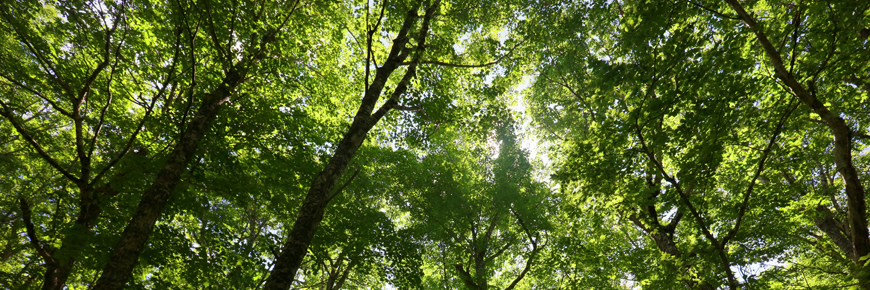
Acadian forest
Cape Breton Highlands National Park
The Acadian forest region occurs in isolated pockets in the lowland coastal fringes and deep, sheltered valleys. Stands of trees in this forest region are separated by the mountains. Cape Breton Highlands National Park protects only about 10% of the Acadian forest in the northern Cape Breton ecosystem.
Trees of the Acadian forest
The mature Acadian forest is composed of mixed hardwoods and softwoods. The composition of individual stands can vary considerably, ranging from pure hardwood valleys to various mixtures of hardwood and softwood species. Characteristic Acadian forest tree species growing in Cape Breton include sugar maple, yellow birch, American beech, balsam fir and eastern hemlock. Red spruce, red oak, white ash, white pine and ironwood are common trees in other Acadian forests but are not common in northern Cape Breton. Several hardwood trees such as American beech, white elm and sugar maple reach the northeastern limit of their ranges in northern Cape Breton.
Wild bounty
The Acadian forest is rich in species and has a luxurious undergrowth of shade-tolerant small trees, low shrubs and ground plants. Lichens grow on trees and rocks within the Acadian forest and mosses can be found on trees, rocks and the forest floor. Mature Acadian forest trees can be very large, with trunks reaching up to a metre across. Hardwood seedlings and saplings dot the shady forest floor, waiting for an older tree to fall so they can take its place. A tree that makes it to maturity may live 100 to 300 years.
Early-blooming wildflowers share the forest floor with the hardwood saplings, taking advantage of what sunlight they can get before the huge trees overhead leaf out. Typical plants of the Acadian forest floor include sensitive fern, striped maple, snowberry and trailing arbutus. A few plants more common in the eastern United States can also be found here. These include rose-twisted stalk, Dutchman's breeches and toothwort.
Characteristic animals found in the Acadian Forest Region include white-tailed deer, red fox, bobcat, deer mouse, masked shrew, red-eyed vireo, blue jay, American redstart and American robin.
Old-growth hardwood forests
The Grande Anse Valley of Cape Breton Highlands National Park is internationally recognized for its old-growth stands of hardwood trees, especially for its nearly pure stands of sugar maple.
The presence and protection of old-growth hardwood forests within the park is important for several reasons. First of all, very little old-growth hardwood forest remains in eastern North America due to extensive logging. Secondly, they are home to many different species and provide critical habitat for several specialized plants and animals including the catbird, "southern" plants such as Dutchman's breeches, and certain lichens such as lungwort. Thirdly, the hardwood forests in northern Cape Breton are naturally isolated in valleys and coastal lowlands. These lowland forests are further disturbed by human settlement, tourism infrastructure and clear-cutting. The presence of the park allows a portion of old-growth hardwood forest to remain in a relatively natural state for our generation and future generations to enjoy.
The old growth hardwood forest in the Grande Anse valley may be suffering from air pollution caused by all the traffic passing through the valley. Currently the park is monitoring levels of ozone in the area.
- Date modified :